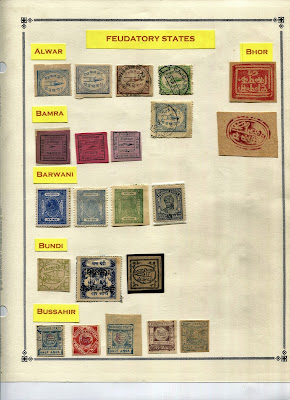An Indian Native Postman
Bud's Big BlueBud's Observations
What exactly is India? Winston Churchill snarked, “India is
a geographical term. It is no more a united nation than the equator.”1
Judging from India’s classical era stamps, Churchill may have had a point. There
were, in all, 43 authorities issuing stamps. BB offers a patchwork of spaces
for Colonial and Feudatory (princely states) stamps, plus a single blank page
for the Convention States -- far too thin for feeder-album fanatics like
me. So, in my albums 26 supplement pages
follow BB’s nine. Moreover, most of the open bits showing on the supplement
pages (see below) have been filled since the scans were made.
The India count is greatly increased by a flood of official
stamps. Every clerk and minor colonial official, it would seem, used and abused
their franking privileges. While all of these are interesting to collectors,
even the most casual among us, the Feudatory stamps are by far the most
enchanting and, as the result, the most often forged. Sorting the honest from
the bogus requires an expertise that’s both expensive and in scarce supply. I’m
saving up for it.
1From a speech at London’s Constitutional Club in
1931, cited by The Economist,
February 9, 2017, and often elsewhere to the dismay of India’s citizens.
Census: 244 in BB spaces, 16 tip-ins, 763 on supplement
pages.
Hyderabad Post Office
Jim's Observations
India was essentially made up of two types: "British India", directly ruled by the Empress of India (Victoria) through the Governor-General, and then the "Princely States" ("Native States"), in which the government of British India, through a Viceroy, granted self-rule through a British matrix.
In 1947, when India and Pakistan became independent from Britain, there were 565 princely states! Most, though, were small, and had contracted out the business of government (and stamp issue production) to the British. The larger ones had their own treaties with Britain, spelling out the rights of the Prince.
Collecting the stamps of India during the classical era is complicated, essentially a world into itself, and fun! One can spend a lifetime with the stamps of India. Big Blue only scratches the surface, but what a surface it is!
One can see by reviewing Bud's pages here that the stamps of India overflow Big Blue's modest representation: in fact, 26 supplementary pages! Enjoy!
India 1854-1940 Blog Post and BB Checklist
India - BOB, Convention States
India - Native States
Page 1
1a
1b
1c
Page 2
2a
2b
2c
2d
Page 3
3a
3b
3c
3d
Page 4
4a
4b
4c
4d
Page 5
5a
5b
5c
Page 6
6a
6b
6c
Page 7
7a
7b
7c
Page 8
8a
8b
8c
Supplements
Page 1
Page 2
Page 3
Page 4
Page 5
Page 6
Page 7
Page 8
Page 9
Page 10
Page 11
Page 12
Page 13
Page 14
Page 15
Page 16
Page 17
Page 18
Page 19
Page 20
Page 21
Page 22
Page 23
Page 24
Page 25
Page 26
Comments appreciated!































































Good day!very nice issye!I would like to ask you if You ever seen a stamp of British India with king Georg 5 or6 (I dont remember),wearing a turban?I cant find this one.I am waiting for your answer.
ReplyDeleteNo, but the crown that George V & VI wears looks "Indian".
Delete(Jim)
Note: There are many Indian States stamps with turbaned rulers, but no George V or VI.
DeleteO.K.thank you so much.I will go on search for this one.
ReplyDeleteif i fined i will share with you its image !!
ReplyDeleteSorry Jim if you see this twice....but I love how Bud has displayed each Convention and Feudatory State. BB is really lacking here, and I'm using the '47 version. Very similar with the Italian Aegean Offices. Boo!
ReplyDeleteI wondered myself what to do, and decided to expand my collecting of the States by using the Minkus Supreme Global pages-- thanks to your reviews, I purchased a set and may even try to put the pages into my BB. Much more coverage- expanded coverage on the Convention states and more Feudatory States, and YES, all stamps have their own space! Thanks again to Bud and Jim!! Ray
Glad you appreciate Bud's presentation - it is indeed inspiring. Yes the Global Supreme actually provides spaces.
Delete